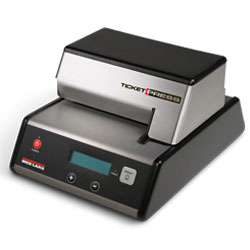Often customers who have printers connected to their scales will ask us about preventive maintenance for keeping their ticket and thermal printers in good working order. Below are a few tips to consider.
There are a few things to consider when it comes to keeping your scale printer in good working order. Some of the key factors to consider include the type of print mechanism, volume of use, environment and paper stock used.
Ticket Printers
First type of printer we’ll look at is the ticket printer. You often see these connected to a truck scale digital weight indicator. These printers seem to have a more opened up layout which means that ticket printers will require more frequent cleaning than other types of printers.
A slide-in ticket printer, for example the Rice Lake TicketPress printer in an air-conditioned office may need cleaning a couple of times a year. That same printer in a more dusty environment such as a feed mill or gravel pit may be exposed to more airborne dust and need a quick cleaning each week. In those especially nasty environments, the operator should be trained to do minor cleaning at the start of each week.
Dirt on the print head is easy for an operator to handle with a cotton swab and isopropyl alcohol. You’ll know when it’s time for cleaning when you start to notice poor print quality.
The head shaft, drive gears and belts are more critical and require professional attention from the service team at Central Carolina Scale. Dirt buildup on these moving parts creates drag, causing extra current draw for the motor, which often leads to a burned out motor or drive transistors. A visual inspection by a professional scale technician during regular preventive maintenance visits is your best guide to prevention. Another great reason to setup a scale check with us on a regular basis.
Thermal Label Printers
This type of printer is usually more protected from airborne dust, but have special needs due to generally higher usage. In addition to the print head, the drive rollers, bearings and clutches sometimes require attention in high-volume applications.
Because they do not use a ribbon, print heads of direct thermal printers can easily pick up debris and should be cleaned regularly. Light streaks in the same place on each label are an indication of a dirty head. On the other hand, thermal transfer printers—with direct ribbon contact—stay relatively clean and can normally go three to four rolls of labels stock between cleanings.
If major adjustments are needed to maintain print quality, it should be your red flag to check bearings and rollers in high-volume label printers. Clean rollers first with alcohol, or even acetone, if they are badly gummed up. If you’re still adjusting frequently, disassemble the label drive mechanism and check the drive roller bearings, replacing if necessary.
Some label printers use felt disks for clutches. A few drops of SAE 5 light machine oil at each cleaning will keep these printers operating quietly.
Quick Maintenance
One of the easiest ways to cut down on required maintenance is to use a dust cover which you can obtain from Central Carolina Scale for most current printers. These heavy, clear plastic covers are custom-made for most popular printers. Not only do they protect from airborne dust during the hours when printers are idle, but some models can be left on during actual use for 24-hour dust protection.
